End-of-Life Care: Current Professional Approaches and Palliative Care
VerifiedAdded on 2023/06/17
|10
|3180
|491
Report
AI Summary
This report provides a comprehensive overview of end-of-life care and current professional approaches, emphasizing the importance of palliative care in managing symptoms and enhancing the quality of life for patients and their families. It explores the benefits of palliative care, including emotional, spiritual, and practical support, and discusses the various stages of end-of-life care. The report also highlights the role of oncologists in providing cancer treatment and making end-of-life decisions, addressing the need for early access to quality care. Furthermore, it touches on medical ethics, such as non-malfeasance, beneficence, and utility, which are crucial in ensuring optimal patient care during this critical phase. The discussion also covers the integration of palliative care across the course of illnesses like dementia, advocating for a shift in perception regarding its implementation. Finally, it addresses the global public health concern of end-of-life care, emphasizing the need for training, public health strategies, and healthcare system reforms.
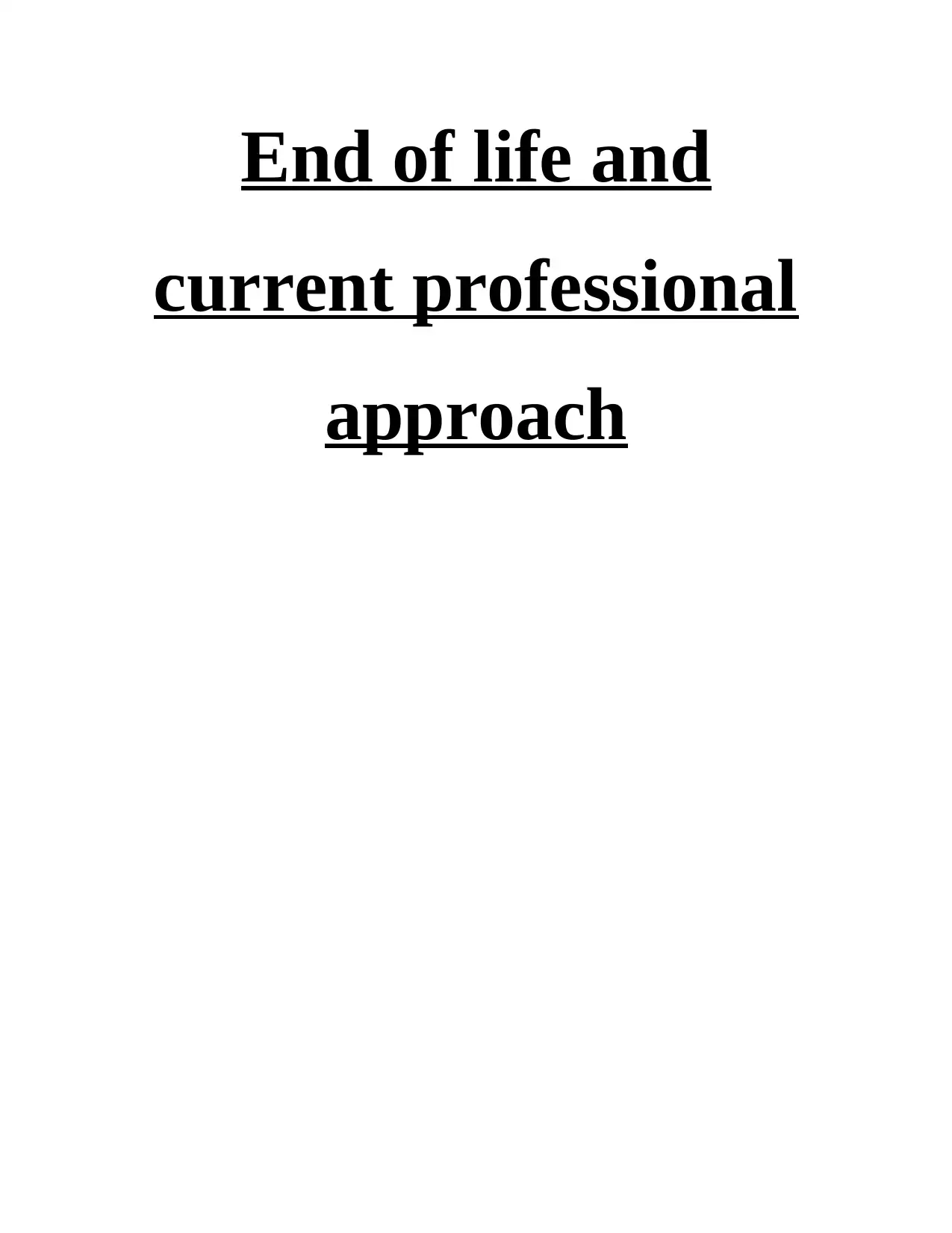
End of life and
current professional
approach
current professional
approach
Paraphrase This Document
Need a fresh take? Get an instant paraphrase of this document with our AI Paraphraser

Table of Contents
Introduction......................................................................................................................................3
Main body........................................................................................................................................3
End of life and current professional approach.............................................................................3
End of life and palliative care......................................................................................................3
Benefits of palliative care............................................................................................................4
Stages of end-of-life care.............................................................................................................5
Oncologist as a health-care service for cancer patients..............................................................6
Conclusion.......................................................................................................................................7
REFERENCES................................................................................................................................9
Introduction......................................................................................................................................3
Main body........................................................................................................................................3
End of life and current professional approach.............................................................................3
End of life and palliative care......................................................................................................3
Benefits of palliative care............................................................................................................4
Stages of end-of-life care.............................................................................................................5
Oncologist as a health-care service for cancer patients..............................................................6
Conclusion.......................................................................................................................................7
REFERENCES................................................................................................................................9
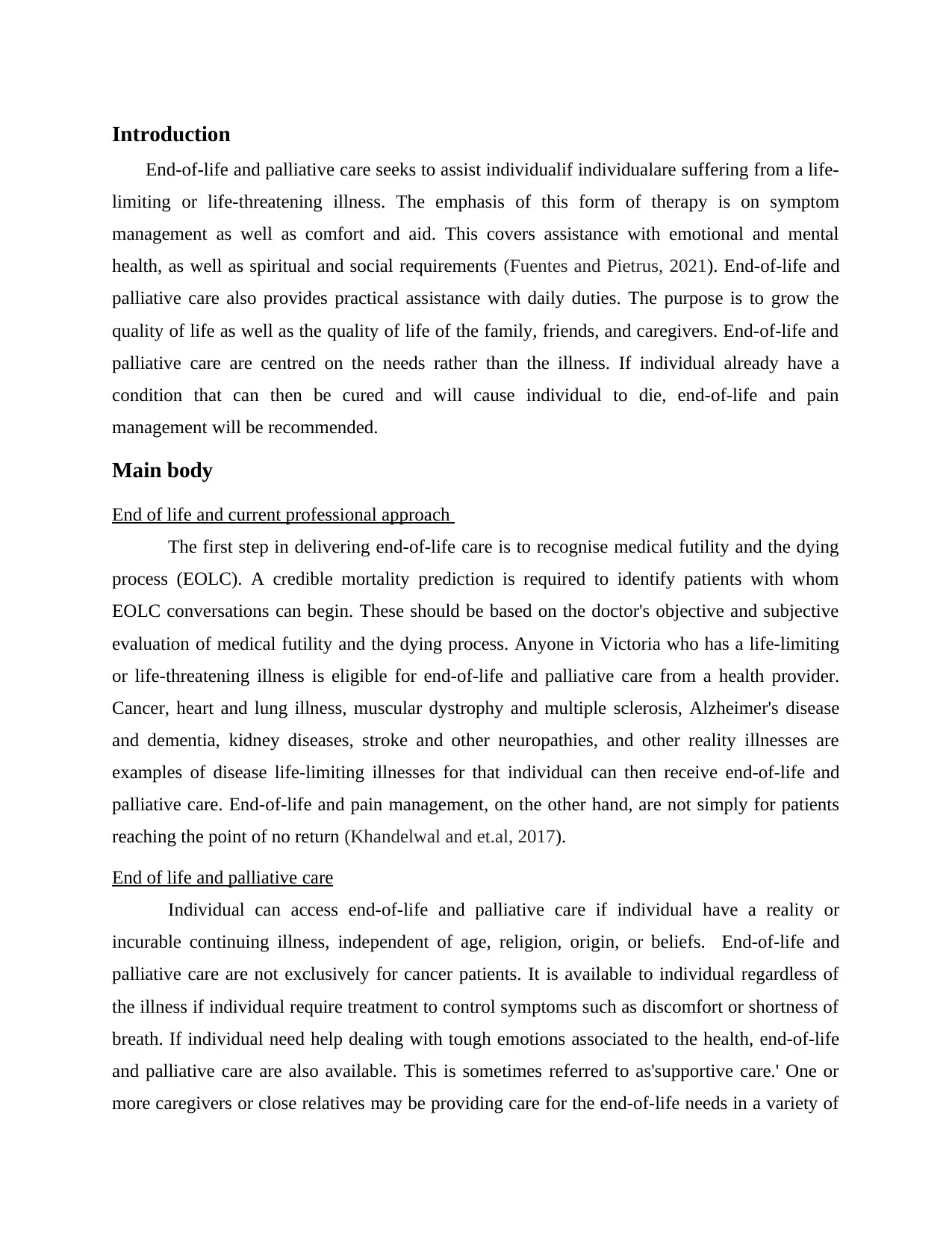
Introduction
End-of-life and palliative care seeks to assist individualif individualare suffering from a life-
limiting or life-threatening illness. The emphasis of this form of therapy is on symptom
management as well as comfort and aid. This covers assistance with emotional and mental
health, as well as spiritual and social requirements (Fuentes and Pietrus, 2021). End-of-life and
palliative care also provides practical assistance with daily duties. The purpose is to grow the
quality of life as well as the quality of life of the family, friends, and caregivers. End-of-life and
palliative care are centred on the needs rather than the illness. If individual already have a
condition that can then be cured and will cause individual to die, end-of-life and pain
management will be recommended.
Main body
End of life and current professional approach
The first step in delivering end-of-life care is to recognise medical futility and the dying
process (EOLC). A credible mortality prediction is required to identify patients with whom
EOLC conversations can begin. These should be based on the doctor's objective and subjective
evaluation of medical futility and the dying process. Anyone in Victoria who has a life-limiting
or life-threatening illness is eligible for end-of-life and palliative care from a health provider.
Cancer, heart and lung illness, muscular dystrophy and multiple sclerosis, Alzheimer's disease
and dementia, kidney diseases, stroke and other neuropathies, and other reality illnesses are
examples of disease life-limiting illnesses for that individual can then receive end-of-life and
palliative care. End-of-life and pain management, on the other hand, are not simply for patients
reaching the point of no return (Khandelwal and et.al, 2017).
End of life and palliative care
Individual can access end-of-life and palliative care if individual have a reality or
incurable continuing illness, independent of age, religion, origin, or beliefs. End-of-life and
palliative care are not exclusively for cancer patients. It is available to individual regardless of
the illness if individual require treatment to control symptoms such as discomfort or shortness of
breath. If individual need help dealing with tough emotions associated to the health, end-of-life
and palliative care are also available. This is sometimes referred to as'supportive care.' One or
more caregivers or close relatives may be providing care for the end-of-life needs in a variety of
End-of-life and palliative care seeks to assist individualif individualare suffering from a life-
limiting or life-threatening illness. The emphasis of this form of therapy is on symptom
management as well as comfort and aid. This covers assistance with emotional and mental
health, as well as spiritual and social requirements (Fuentes and Pietrus, 2021). End-of-life and
palliative care also provides practical assistance with daily duties. The purpose is to grow the
quality of life as well as the quality of life of the family, friends, and caregivers. End-of-life and
palliative care are centred on the needs rather than the illness. If individual already have a
condition that can then be cured and will cause individual to die, end-of-life and pain
management will be recommended.
Main body
End of life and current professional approach
The first step in delivering end-of-life care is to recognise medical futility and the dying
process (EOLC). A credible mortality prediction is required to identify patients with whom
EOLC conversations can begin. These should be based on the doctor's objective and subjective
evaluation of medical futility and the dying process. Anyone in Victoria who has a life-limiting
or life-threatening illness is eligible for end-of-life and palliative care from a health provider.
Cancer, heart and lung illness, muscular dystrophy and multiple sclerosis, Alzheimer's disease
and dementia, kidney diseases, stroke and other neuropathies, and other reality illnesses are
examples of disease life-limiting illnesses for that individual can then receive end-of-life and
palliative care. End-of-life and pain management, on the other hand, are not simply for patients
reaching the point of no return (Khandelwal and et.al, 2017).
End of life and palliative care
Individual can access end-of-life and palliative care if individual have a reality or
incurable continuing illness, independent of age, religion, origin, or beliefs. End-of-life and
palliative care are not exclusively for cancer patients. It is available to individual regardless of
the illness if individual require treatment to control symptoms such as discomfort or shortness of
breath. If individual need help dealing with tough emotions associated to the health, end-of-life
and palliative care are also available. This is sometimes referred to as'supportive care.' One or
more caregivers or close relatives may be providing care for the end-of-life needs in a variety of
⊘ This is a preview!⊘
Do you want full access?
Subscribe today to unlock all pages.

Trusted by 1+ million students worldwide
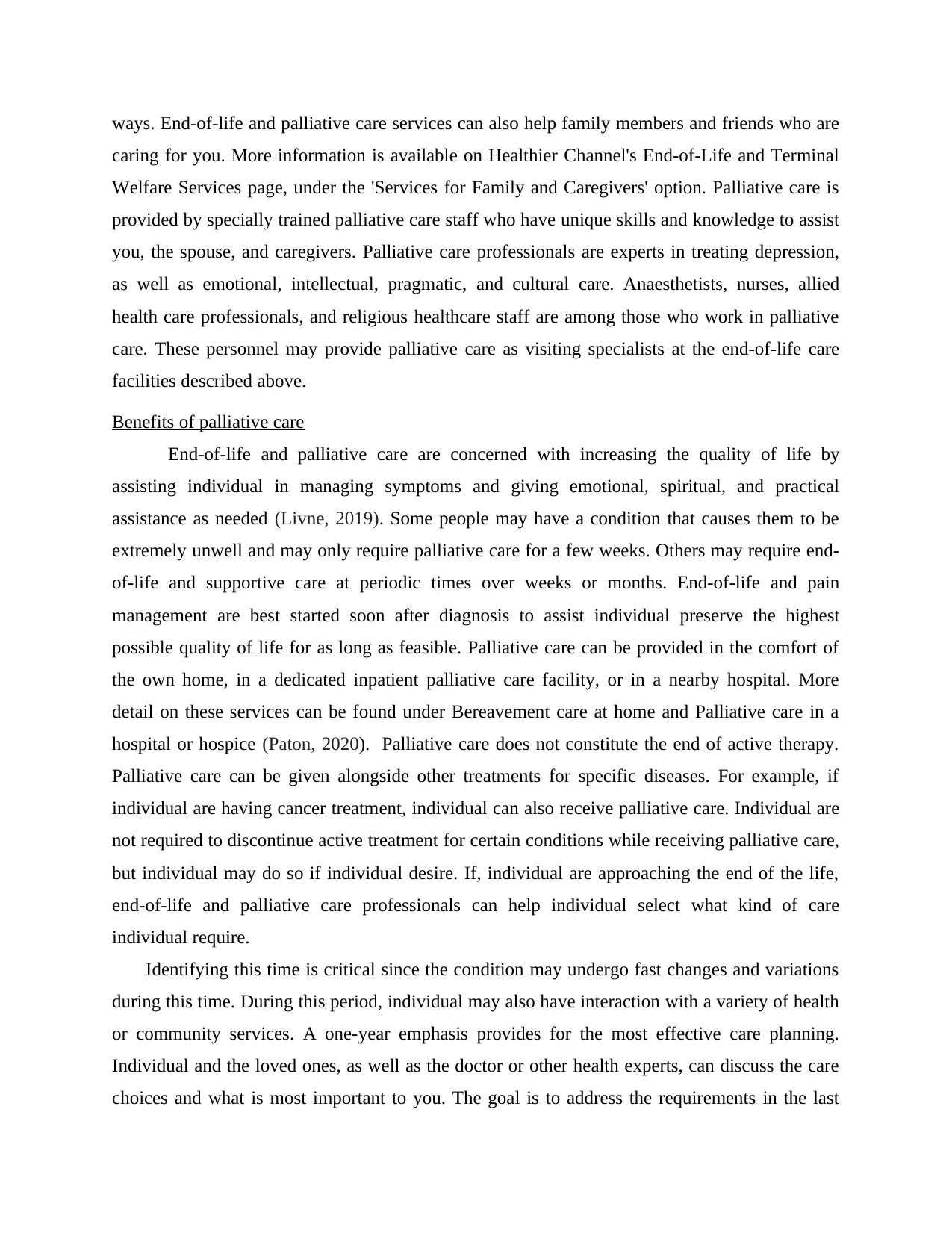
ways. End-of-life and palliative care services can also help family members and friends who are
caring for you. More information is available on Healthier Channel's End-of-Life and Terminal
Welfare Services page, under the 'Services for Family and Caregivers' option. Palliative care is
provided by specially trained palliative care staff who have unique skills and knowledge to assist
you, the spouse, and caregivers. Palliative care professionals are experts in treating depression,
as well as emotional, intellectual, pragmatic, and cultural care. Anaesthetists, nurses, allied
health care professionals, and religious healthcare staff are among those who work in palliative
care. These personnel may provide palliative care as visiting specialists at the end-of-life care
facilities described above.
Benefits of palliative care
End-of-life and palliative care are concerned with increasing the quality of life by
assisting individual in managing symptoms and giving emotional, spiritual, and practical
assistance as needed (Livne, 2019). Some people may have a condition that causes them to be
extremely unwell and may only require palliative care for a few weeks. Others may require end-
of-life and supportive care at periodic times over weeks or months. End-of-life and pain
management are best started soon after diagnosis to assist individual preserve the highest
possible quality of life for as long as feasible. Palliative care can be provided in the comfort of
the own home, in a dedicated inpatient palliative care facility, or in a nearby hospital. More
detail on these services can be found under Bereavement care at home and Palliative care in a
hospital or hospice (Paton, 2020). Palliative care does not constitute the end of active therapy.
Palliative care can be given alongside other treatments for specific diseases. For example, if
individual are having cancer treatment, individual can also receive palliative care. Individual are
not required to discontinue active treatment for certain conditions while receiving palliative care,
but individual may do so if individual desire. If, individual are approaching the end of the life,
end-of-life and palliative care professionals can help individual select what kind of care
individual require.
Identifying this time is critical since the condition may undergo fast changes and variations
during this time. During this period, individual may also have interaction with a variety of health
or community services. A one-year emphasis provides for the most effective care planning.
Individual and the loved ones, as well as the doctor or other health experts, can discuss the care
choices and what is most important to you. The goal is to address the requirements in the last
caring for you. More information is available on Healthier Channel's End-of-Life and Terminal
Welfare Services page, under the 'Services for Family and Caregivers' option. Palliative care is
provided by specially trained palliative care staff who have unique skills and knowledge to assist
you, the spouse, and caregivers. Palliative care professionals are experts in treating depression,
as well as emotional, intellectual, pragmatic, and cultural care. Anaesthetists, nurses, allied
health care professionals, and religious healthcare staff are among those who work in palliative
care. These personnel may provide palliative care as visiting specialists at the end-of-life care
facilities described above.
Benefits of palliative care
End-of-life and palliative care are concerned with increasing the quality of life by
assisting individual in managing symptoms and giving emotional, spiritual, and practical
assistance as needed (Livne, 2019). Some people may have a condition that causes them to be
extremely unwell and may only require palliative care for a few weeks. Others may require end-
of-life and supportive care at periodic times over weeks or months. End-of-life and pain
management are best started soon after diagnosis to assist individual preserve the highest
possible quality of life for as long as feasible. Palliative care can be provided in the comfort of
the own home, in a dedicated inpatient palliative care facility, or in a nearby hospital. More
detail on these services can be found under Bereavement care at home and Palliative care in a
hospital or hospice (Paton, 2020). Palliative care does not constitute the end of active therapy.
Palliative care can be given alongside other treatments for specific diseases. For example, if
individual are having cancer treatment, individual can also receive palliative care. Individual are
not required to discontinue active treatment for certain conditions while receiving palliative care,
but individual may do so if individual desire. If, individual are approaching the end of the life,
end-of-life and palliative care professionals can help individual select what kind of care
individual require.
Identifying this time is critical since the condition may undergo fast changes and variations
during this time. During this period, individual may also have interaction with a variety of health
or community services. A one-year emphasis provides for the most effective care planning.
Individual and the loved ones, as well as the doctor or other health experts, can discuss the care
choices and what is most important to you. The goal is to address the requirements in the last
Paraphrase This Document
Need a fresh take? Get an instant paraphrase of this document with our AI Paraphraser
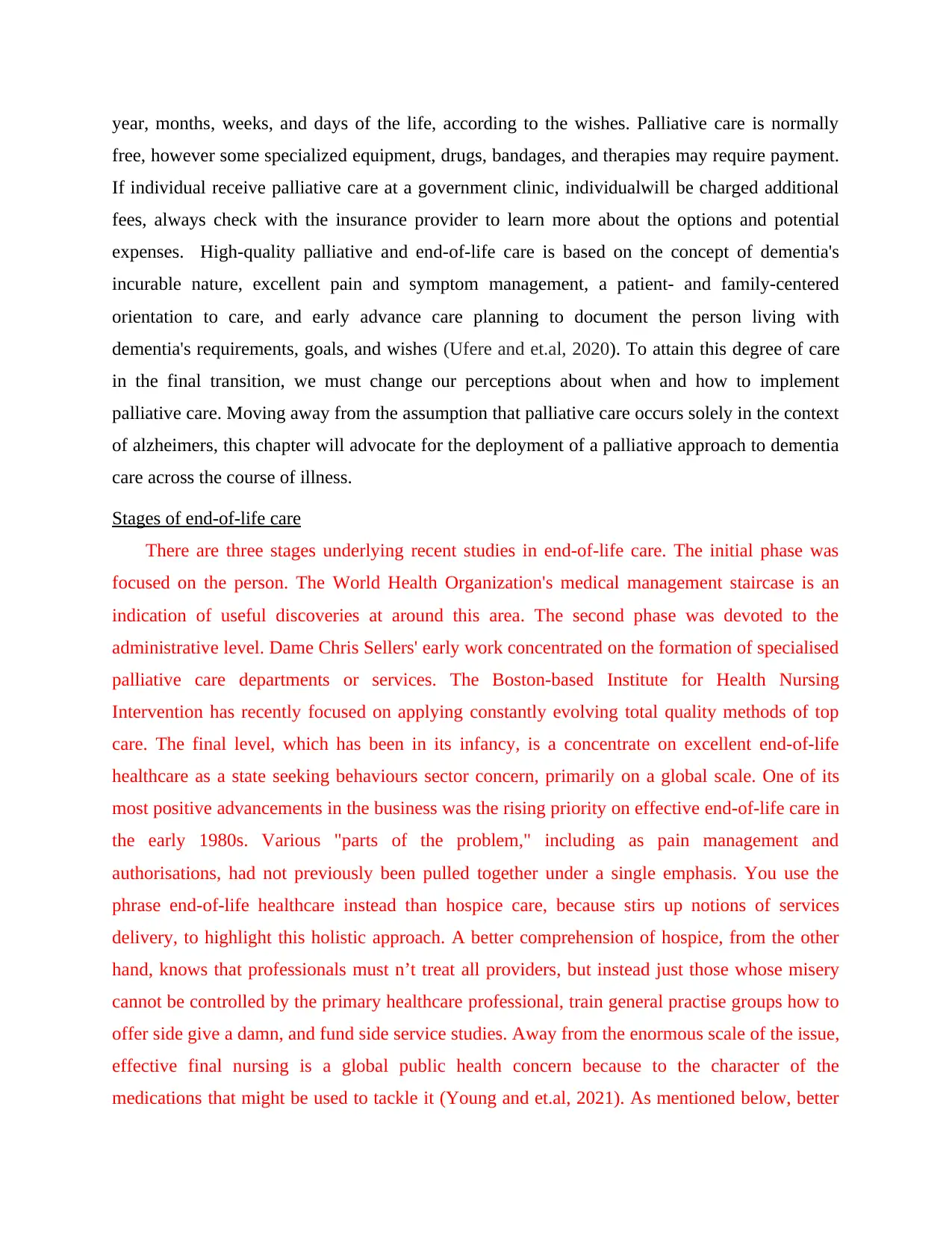
year, months, weeks, and days of the life, according to the wishes. Palliative care is normally
free, however some specialized equipment, drugs, bandages, and therapies may require payment.
If individual receive palliative care at a government clinic, individualwill be charged additional
fees, always check with the insurance provider to learn more about the options and potential
expenses. High-quality palliative and end-of-life care is based on the concept of dementia's
incurable nature, excellent pain and symptom management, a patient- and family-centered
orientation to care, and early advance care planning to document the person living with
dementia's requirements, goals, and wishes (Ufere and et.al, 2020). To attain this degree of care
in the final transition, we must change our perceptions about when and how to implement
palliative care. Moving away from the assumption that palliative care occurs solely in the context
of alzheimers, this chapter will advocate for the deployment of a palliative approach to dementia
care across the course of illness.
Stages of end-of-life care
There are three stages underlying recent studies in end-of-life care. The initial phase was
focused on the person. The World Health Organization's medical management staircase is an
indication of useful discoveries at around this area. The second phase was devoted to the
administrative level. Dame Chris Sellers' early work concentrated on the formation of specialised
palliative care departments or services. The Boston-based Institute for Health Nursing
Intervention has recently focused on applying constantly evolving total quality methods of top
care. The final level, which has been in its infancy, is a concentrate on excellent end-of-life
healthcare as a state seeking behaviours sector concern, primarily on a global scale. One of its
most positive advancements in the business was the rising priority on effective end-of-life care in
the early 1980s. Various "parts of the problem," including as pain management and
authorisations, had not previously been pulled together under a single emphasis. You use the
phrase end-of-life healthcare instead than hospice care, because stirs up notions of services
delivery, to highlight this holistic approach. A better comprehension of hospice, from the other
hand, knows that professionals must n’t treat all providers, but instead just those whose misery
cannot be controlled by the primary healthcare professional, train general practise groups how to
offer side give a damn, and fund side service studies. Away from the enormous scale of the issue,
effective final nursing is a global public health concern because to the character of the
medications that might be used to tackle it (Young and et.al, 2021). As mentioned below, better
free, however some specialized equipment, drugs, bandages, and therapies may require payment.
If individual receive palliative care at a government clinic, individualwill be charged additional
fees, always check with the insurance provider to learn more about the options and potential
expenses. High-quality palliative and end-of-life care is based on the concept of dementia's
incurable nature, excellent pain and symptom management, a patient- and family-centered
orientation to care, and early advance care planning to document the person living with
dementia's requirements, goals, and wishes (Ufere and et.al, 2020). To attain this degree of care
in the final transition, we must change our perceptions about when and how to implement
palliative care. Moving away from the assumption that palliative care occurs solely in the context
of alzheimers, this chapter will advocate for the deployment of a palliative approach to dementia
care across the course of illness.
Stages of end-of-life care
There are three stages underlying recent studies in end-of-life care. The initial phase was
focused on the person. The World Health Organization's medical management staircase is an
indication of useful discoveries at around this area. The second phase was devoted to the
administrative level. Dame Chris Sellers' early work concentrated on the formation of specialised
palliative care departments or services. The Boston-based Institute for Health Nursing
Intervention has recently focused on applying constantly evolving total quality methods of top
care. The final level, which has been in its infancy, is a concentrate on excellent end-of-life
healthcare as a state seeking behaviours sector concern, primarily on a global scale. One of its
most positive advancements in the business was the rising priority on effective end-of-life care in
the early 1980s. Various "parts of the problem," including as pain management and
authorisations, had not previously been pulled together under a single emphasis. You use the
phrase end-of-life healthcare instead than hospice care, because stirs up notions of services
delivery, to highlight this holistic approach. A better comprehension of hospice, from the other
hand, knows that professionals must n’t treat all providers, but instead just those whose misery
cannot be controlled by the primary healthcare professional, train general practise groups how to
offer side give a damn, and fund side service studies. Away from the enormous scale of the issue,
effective final nursing is a global public health concern because to the character of the
medications that might be used to tackle it (Young and et.al, 2021). As mentioned below, better
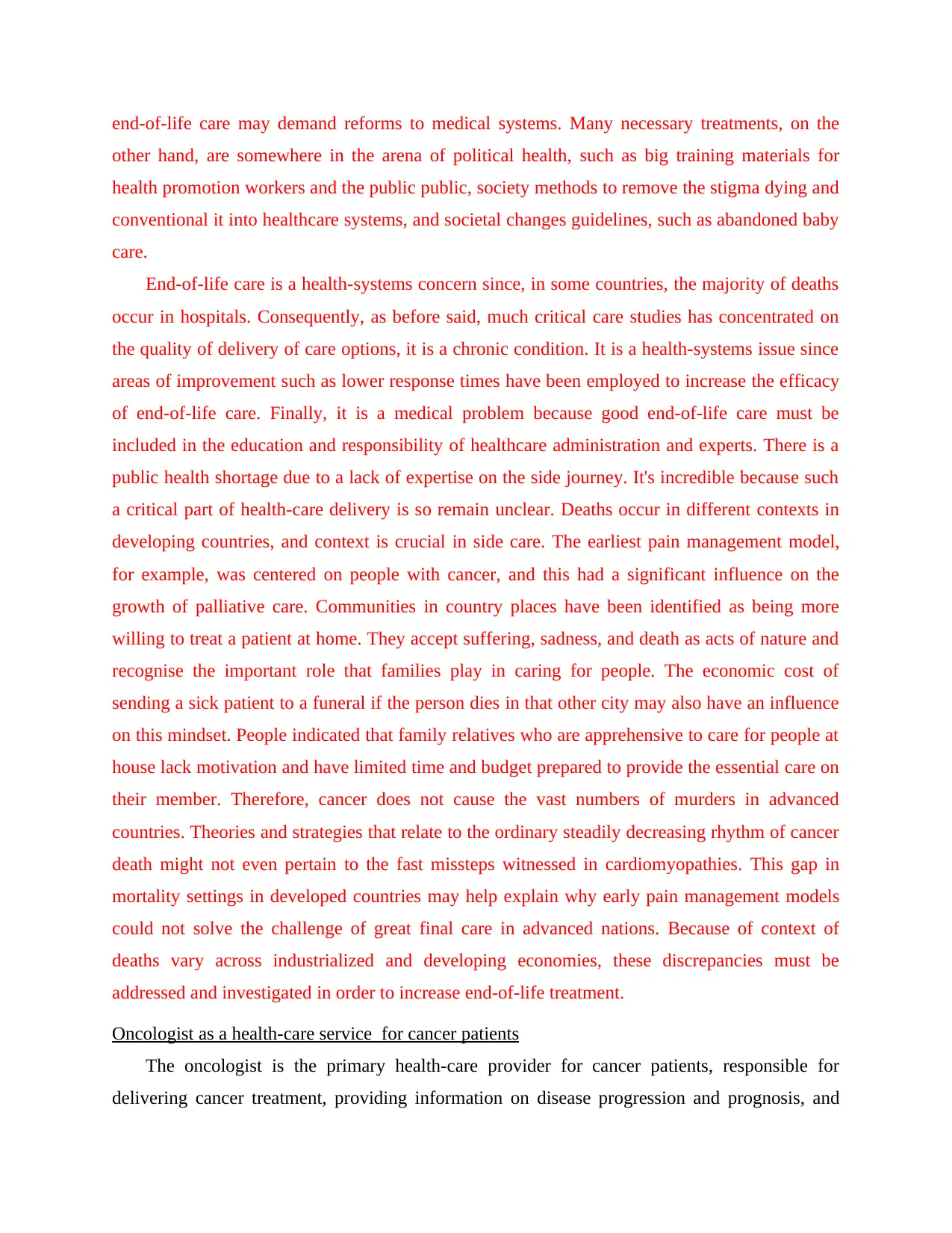
end-of-life care may demand reforms to medical systems. Many necessary treatments, on the
other hand, are somewhere in the arena of political health, such as big training materials for
health promotion workers and the public public, society methods to remove the stigma dying and
conventional it into healthcare systems, and societal changes guidelines, such as abandoned baby
care.
End-of-life care is a health-systems concern since, in some countries, the majority of deaths
occur in hospitals. Consequently, as before said, much critical care studies has concentrated on
the quality of delivery of care options, it is a chronic condition. It is a health-systems issue since
areas of improvement such as lower response times have been employed to increase the efficacy
of end-of-life care. Finally, it is a medical problem because good end-of-life care must be
included in the education and responsibility of healthcare administration and experts. There is a
public health shortage due to a lack of expertise on the side journey. It's incredible because such
a critical part of health-care delivery is so remain unclear. Deaths occur in different contexts in
developing countries, and context is crucial in side care. The earliest pain management model,
for example, was centered on people with cancer, and this had a significant influence on the
growth of palliative care. Communities in country places have been identified as being more
willing to treat a patient at home. They accept suffering, sadness, and death as acts of nature and
recognise the important role that families play in caring for people. The economic cost of
sending a sick patient to a funeral if the person dies in that other city may also have an influence
on this mindset. People indicated that family relatives who are apprehensive to care for people at
house lack motivation and have limited time and budget prepared to provide the essential care on
their member. Therefore, cancer does not cause the vast numbers of murders in advanced
countries. Theories and strategies that relate to the ordinary steadily decreasing rhythm of cancer
death might not even pertain to the fast missteps witnessed in cardiomyopathies. This gap in
mortality settings in developed countries may help explain why early pain management models
could not solve the challenge of great final care in advanced nations. Because of context of
deaths vary across industrialized and developing economies, these discrepancies must be
addressed and investigated in order to increase end-of-life treatment.
Oncologist as a health-care service for cancer patients
The oncologist is the primary health-care provider for cancer patients, responsible for
delivering cancer treatment, providing information on disease progression and prognosis, and
other hand, are somewhere in the arena of political health, such as big training materials for
health promotion workers and the public public, society methods to remove the stigma dying and
conventional it into healthcare systems, and societal changes guidelines, such as abandoned baby
care.
End-of-life care is a health-systems concern since, in some countries, the majority of deaths
occur in hospitals. Consequently, as before said, much critical care studies has concentrated on
the quality of delivery of care options, it is a chronic condition. It is a health-systems issue since
areas of improvement such as lower response times have been employed to increase the efficacy
of end-of-life care. Finally, it is a medical problem because good end-of-life care must be
included in the education and responsibility of healthcare administration and experts. There is a
public health shortage due to a lack of expertise on the side journey. It's incredible because such
a critical part of health-care delivery is so remain unclear. Deaths occur in different contexts in
developing countries, and context is crucial in side care. The earliest pain management model,
for example, was centered on people with cancer, and this had a significant influence on the
growth of palliative care. Communities in country places have been identified as being more
willing to treat a patient at home. They accept suffering, sadness, and death as acts of nature and
recognise the important role that families play in caring for people. The economic cost of
sending a sick patient to a funeral if the person dies in that other city may also have an influence
on this mindset. People indicated that family relatives who are apprehensive to care for people at
house lack motivation and have limited time and budget prepared to provide the essential care on
their member. Therefore, cancer does not cause the vast numbers of murders in advanced
countries. Theories and strategies that relate to the ordinary steadily decreasing rhythm of cancer
death might not even pertain to the fast missteps witnessed in cardiomyopathies. This gap in
mortality settings in developed countries may help explain why early pain management models
could not solve the challenge of great final care in advanced nations. Because of context of
deaths vary across industrialized and developing economies, these discrepancies must be
addressed and investigated in order to increase end-of-life treatment.
Oncologist as a health-care service for cancer patients
The oncologist is the primary health-care provider for cancer patients, responsible for
delivering cancer treatment, providing information on disease progression and prognosis, and
⊘ This is a preview!⊘
Do you want full access?
Subscribe today to unlock all pages.

Trusted by 1+ million students worldwide
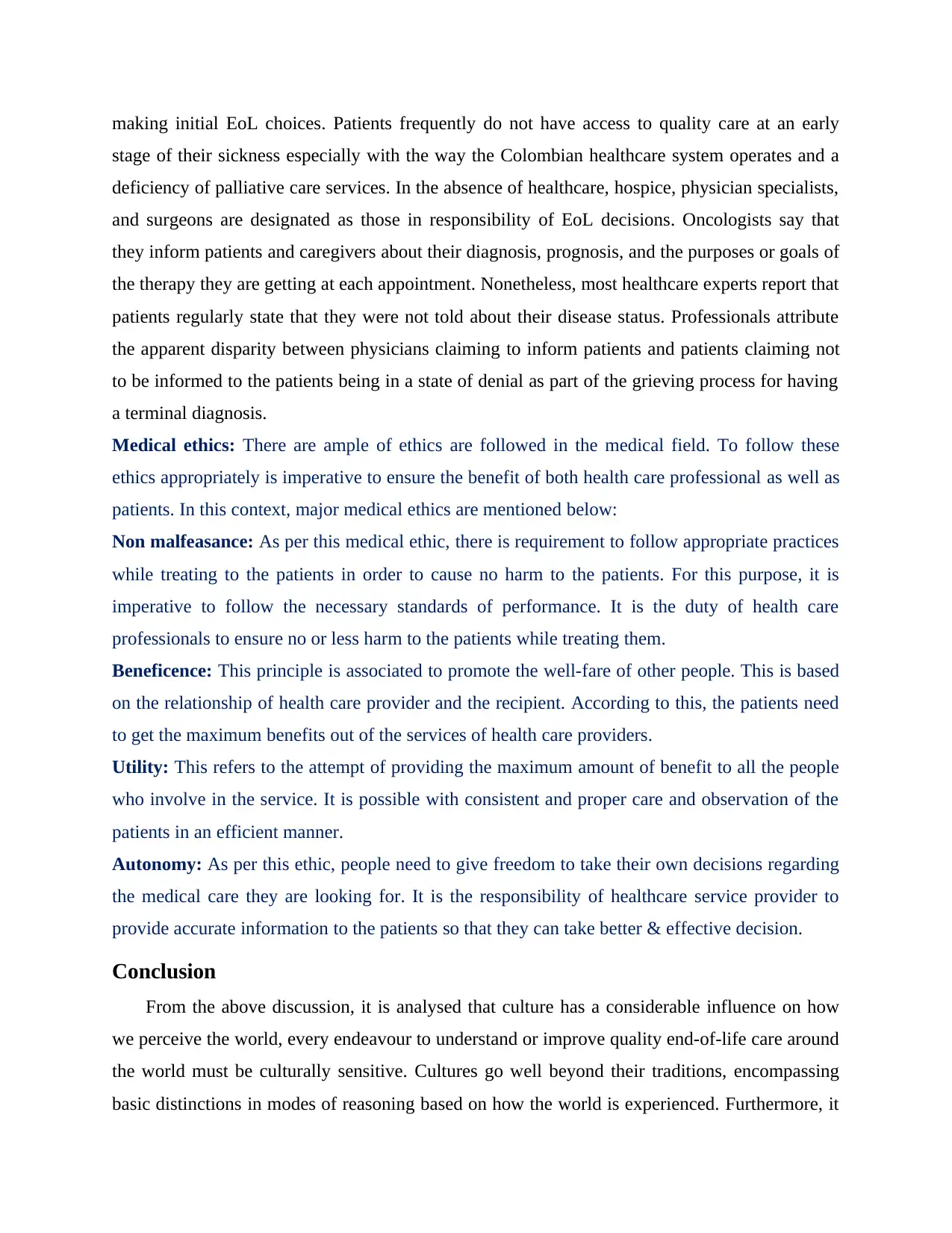
making initial EoL choices. Patients frequently do not have access to quality care at an early
stage of their sickness especially with the way the Colombian healthcare system operates and a
deficiency of palliative care services. In the absence of healthcare, hospice, physician specialists,
and surgeons are designated as those in responsibility of EoL decisions. Oncologists say that
they inform patients and caregivers about their diagnosis, prognosis, and the purposes or goals of
the therapy they are getting at each appointment. Nonetheless, most healthcare experts report that
patients regularly state that they were not told about their disease status. Professionals attribute
the apparent disparity between physicians claiming to inform patients and patients claiming not
to be informed to the patients being in a state of denial as part of the grieving process for having
a terminal diagnosis.
Medical ethics: There are ample of ethics are followed in the medical field. To follow these
ethics appropriately is imperative to ensure the benefit of both health care professional as well as
patients. In this context, major medical ethics are mentioned below:
Non malfeasance: As per this medical ethic, there is requirement to follow appropriate practices
while treating to the patients in order to cause no harm to the patients. For this purpose, it is
imperative to follow the necessary standards of performance. It is the duty of health care
professionals to ensure no or less harm to the patients while treating them.
Beneficence: This principle is associated to promote the well-fare of other people. This is based
on the relationship of health care provider and the recipient. According to this, the patients need
to get the maximum benefits out of the services of health care providers.
Utility: This refers to the attempt of providing the maximum amount of benefit to all the people
who involve in the service. It is possible with consistent and proper care and observation of the
patients in an efficient manner.
Autonomy: As per this ethic, people need to give freedom to take their own decisions regarding
the medical care they are looking for. It is the responsibility of healthcare service provider to
provide accurate information to the patients so that they can take better & effective decision.
Conclusion
From the above discussion, it is analysed that culture has a considerable influence on how
we perceive the world, every endeavour to understand or improve quality end-of-life care around
the world must be culturally sensitive. Cultures go well beyond their traditions, encompassing
basic distinctions in modes of reasoning based on how the world is experienced. Furthermore, it
stage of their sickness especially with the way the Colombian healthcare system operates and a
deficiency of palliative care services. In the absence of healthcare, hospice, physician specialists,
and surgeons are designated as those in responsibility of EoL decisions. Oncologists say that
they inform patients and caregivers about their diagnosis, prognosis, and the purposes or goals of
the therapy they are getting at each appointment. Nonetheless, most healthcare experts report that
patients regularly state that they were not told about their disease status. Professionals attribute
the apparent disparity between physicians claiming to inform patients and patients claiming not
to be informed to the patients being in a state of denial as part of the grieving process for having
a terminal diagnosis.
Medical ethics: There are ample of ethics are followed in the medical field. To follow these
ethics appropriately is imperative to ensure the benefit of both health care professional as well as
patients. In this context, major medical ethics are mentioned below:
Non malfeasance: As per this medical ethic, there is requirement to follow appropriate practices
while treating to the patients in order to cause no harm to the patients. For this purpose, it is
imperative to follow the necessary standards of performance. It is the duty of health care
professionals to ensure no or less harm to the patients while treating them.
Beneficence: This principle is associated to promote the well-fare of other people. This is based
on the relationship of health care provider and the recipient. According to this, the patients need
to get the maximum benefits out of the services of health care providers.
Utility: This refers to the attempt of providing the maximum amount of benefit to all the people
who involve in the service. It is possible with consistent and proper care and observation of the
patients in an efficient manner.
Autonomy: As per this ethic, people need to give freedom to take their own decisions regarding
the medical care they are looking for. It is the responsibility of healthcare service provider to
provide accurate information to the patients so that they can take better & effective decision.
Conclusion
From the above discussion, it is analysed that culture has a considerable influence on how
we perceive the world, every endeavour to understand or improve quality end-of-life care around
the world must be culturally sensitive. Cultures go well beyond their traditions, encompassing
basic distinctions in modes of reasoning based on how the world is experienced. Furthermore, it
Paraphrase This Document
Need a fresh take? Get an instant paraphrase of this document with our AI Paraphraser

is well understood that attitudes about end-of-life care vary according to culture, society, and
period. When persons planning or giving health care and those receiving health care originate
from different cultural backgrounds, they frequently interact under the influence of implicit
assumptions that are so dissimilar that effective communication is hampered and initiatives may
fail entirely. Trying to impose Western attitudes on end-of-life care to developing countries is
impractical and likely to fail.
period. When persons planning or giving health care and those receiving health care originate
from different cultural backgrounds, they frequently interact under the influence of implicit
assumptions that are so dissimilar that effective communication is hampered and initiatives may
fail entirely. Trying to impose Western attitudes on end-of-life care to developing countries is
impractical and likely to fail.

REFERENCES
Books and Journals
Arnold, L and et.al, 2019. Medical leaders identify personal characteristics and experiences that
contribute to leadership success in medicine. MedEdPublish, 8.
Ayeleke, R.O and et.al, 2019. Impact of training and professional development on health
management and leadership competence: a mixed methods systematic review. Journal of health
organization and management.
Fuentes, B. and Pietrus, M., 2021. Connecting the Dots Between Theoretical Knowledge and
Clinical Practice: A Palliative Care Social Worker Process Improvement Project in an
Acute Hospital Setting. Journal of Social Work in End-of-Life & Palliative Care, pp.1-12.
Gibson, R., Till, A. and Adshead, G., 2019. Psychotherapeutic leadership and containment in
psychiatry. BJPsych Advances, 25(2), pp.133-141.
Gutierrez, A.N., Halvorsen, P.H. and Rong, Y., 2017. MBA degree is needed for leadership roles
in Medical Physics profession. Journal of applied clinical medical physics, 18(6), p.6.
Hamilton, J.L., 2021. Educationalist Leadership in Medical Schools (Doctoral dissertation,
Northeastern University).
Khandelwal, N., Curtis, J.R., Freedman, V.A., Kasper, J.D., Gozalo, P., Engelberg, R.A. and
Teno, J.M., 2017. How often is end-of-life care in the United States inconsistent with patients'
goals of care?. Journal of palliative medicine, 20(12), pp.1400-1404.
Livne, R., 2019. Values at the end of life: The logic of palliative care. Social Forces.
McKimm, J., The assessment of leadership development in the medical undergraduate
curriculum: a UK consensus statement.
Mokshagundam, S., and et.al, 2019. Engaging medical students in leadership development. Medical
Science Educator, 29(3), pp.849-853.
Paton, N., 2020. Worker shortages pose'large threat'to future of OH. Occupational Health &
Wellbeing, 72(7), pp.4-4.
Rashi, T., 2021. The Joint Responsibility of the Religious Leadership and Medical Stuff to
Encourage the Vaccination of Children. Acta Paediatrica.
Shaffer, L.A. and et.al, 2021. Psychologists’ leadership roles and leadership training needs in
academic health centers. Journal of clinical psychology in medical settings, 28(2), pp.252-261.
Books and Journals
Arnold, L and et.al, 2019. Medical leaders identify personal characteristics and experiences that
contribute to leadership success in medicine. MedEdPublish, 8.
Ayeleke, R.O and et.al, 2019. Impact of training and professional development on health
management and leadership competence: a mixed methods systematic review. Journal of health
organization and management.
Fuentes, B. and Pietrus, M., 2021. Connecting the Dots Between Theoretical Knowledge and
Clinical Practice: A Palliative Care Social Worker Process Improvement Project in an
Acute Hospital Setting. Journal of Social Work in End-of-Life & Palliative Care, pp.1-12.
Gibson, R., Till, A. and Adshead, G., 2019. Psychotherapeutic leadership and containment in
psychiatry. BJPsych Advances, 25(2), pp.133-141.
Gutierrez, A.N., Halvorsen, P.H. and Rong, Y., 2017. MBA degree is needed for leadership roles
in Medical Physics profession. Journal of applied clinical medical physics, 18(6), p.6.
Hamilton, J.L., 2021. Educationalist Leadership in Medical Schools (Doctoral dissertation,
Northeastern University).
Khandelwal, N., Curtis, J.R., Freedman, V.A., Kasper, J.D., Gozalo, P., Engelberg, R.A. and
Teno, J.M., 2017. How often is end-of-life care in the United States inconsistent with patients'
goals of care?. Journal of palliative medicine, 20(12), pp.1400-1404.
Livne, R., 2019. Values at the end of life: The logic of palliative care. Social Forces.
McKimm, J., The assessment of leadership development in the medical undergraduate
curriculum: a UK consensus statement.
Mokshagundam, S., and et.al, 2019. Engaging medical students in leadership development. Medical
Science Educator, 29(3), pp.849-853.
Paton, N., 2020. Worker shortages pose'large threat'to future of OH. Occupational Health &
Wellbeing, 72(7), pp.4-4.
Rashi, T., 2021. The Joint Responsibility of the Religious Leadership and Medical Stuff to
Encourage the Vaccination of Children. Acta Paediatrica.
Shaffer, L.A. and et.al, 2021. Psychologists’ leadership roles and leadership training needs in
academic health centers. Journal of clinical psychology in medical settings, 28(2), pp.252-261.
⊘ This is a preview!⊘
Do you want full access?
Subscribe today to unlock all pages.

Trusted by 1+ million students worldwide
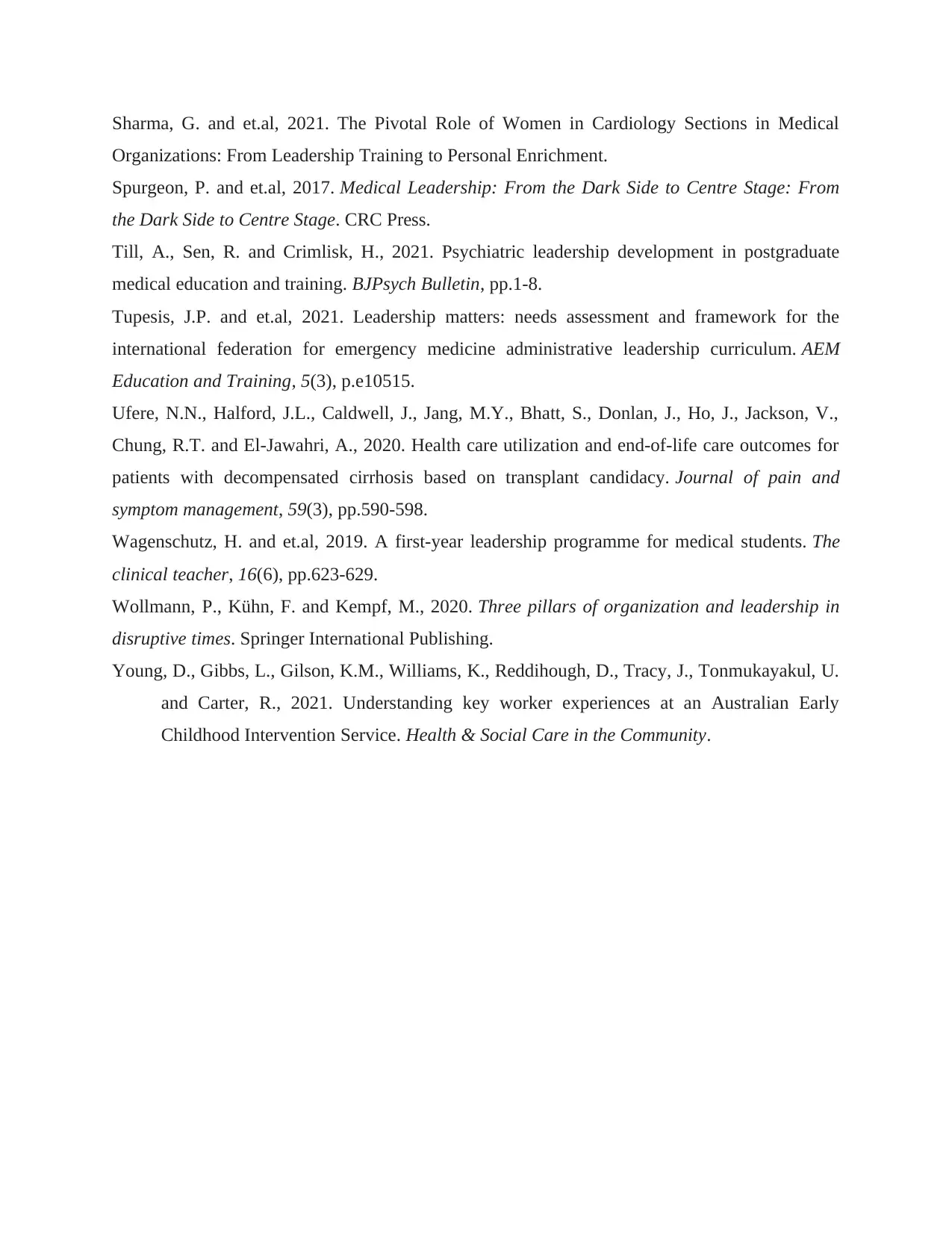
Sharma, G. and et.al, 2021. The Pivotal Role of Women in Cardiology Sections in Medical
Organizations: From Leadership Training to Personal Enrichment.
Spurgeon, P. and et.al, 2017. Medical Leadership: From the Dark Side to Centre Stage: From
the Dark Side to Centre Stage. CRC Press.
Till, A., Sen, R. and Crimlisk, H., 2021. Psychiatric leadership development in postgraduate
medical education and training. BJPsych Bulletin, pp.1-8.
Tupesis, J.P. and et.al, 2021. Leadership matters: needs assessment and framework for the
international federation for emergency medicine administrative leadership curriculum. AEM
Education and Training, 5(3), p.e10515.
Ufere, N.N., Halford, J.L., Caldwell, J., Jang, M.Y., Bhatt, S., Donlan, J., Ho, J., Jackson, V.,
Chung, R.T. and El-Jawahri, A., 2020. Health care utilization and end-of-life care outcomes for
patients with decompensated cirrhosis based on transplant candidacy. Journal of pain and
symptom management, 59(3), pp.590-598.
Wagenschutz, H. and et.al, 2019. A first‐year leadership programme for medical students. The
clinical teacher, 16(6), pp.623-629.
Wollmann, P., Kühn, F. and Kempf, M., 2020. Three pillars of organization and leadership in
disruptive times. Springer International Publishing.
Young, D., Gibbs, L., Gilson, K.M., Williams, K., Reddihough, D., Tracy, J., Tonmukayakul, U.
and Carter, R., 2021. Understanding key worker experiences at an Australian Early
Childhood Intervention Service. Health & Social Care in the Community.
Organizations: From Leadership Training to Personal Enrichment.
Spurgeon, P. and et.al, 2017. Medical Leadership: From the Dark Side to Centre Stage: From
the Dark Side to Centre Stage. CRC Press.
Till, A., Sen, R. and Crimlisk, H., 2021. Psychiatric leadership development in postgraduate
medical education and training. BJPsych Bulletin, pp.1-8.
Tupesis, J.P. and et.al, 2021. Leadership matters: needs assessment and framework for the
international federation for emergency medicine administrative leadership curriculum. AEM
Education and Training, 5(3), p.e10515.
Ufere, N.N., Halford, J.L., Caldwell, J., Jang, M.Y., Bhatt, S., Donlan, J., Ho, J., Jackson, V.,
Chung, R.T. and El-Jawahri, A., 2020. Health care utilization and end-of-life care outcomes for
patients with decompensated cirrhosis based on transplant candidacy. Journal of pain and
symptom management, 59(3), pp.590-598.
Wagenschutz, H. and et.al, 2019. A first‐year leadership programme for medical students. The
clinical teacher, 16(6), pp.623-629.
Wollmann, P., Kühn, F. and Kempf, M., 2020. Three pillars of organization and leadership in
disruptive times. Springer International Publishing.
Young, D., Gibbs, L., Gilson, K.M., Williams, K., Reddihough, D., Tracy, J., Tonmukayakul, U.
and Carter, R., 2021. Understanding key worker experiences at an Australian Early
Childhood Intervention Service. Health & Social Care in the Community.
1 out of 10
Related Documents
Your All-in-One AI-Powered Toolkit for Academic Success.
+13062052269
info@desklib.com
Available 24*7 on WhatsApp / Email
![[object Object]](/_next/static/media/star-bottom.7253800d.svg)
Unlock your academic potential
Copyright © 2020–2025 A2Z Services. All Rights Reserved. Developed and managed by ZUCOL.





